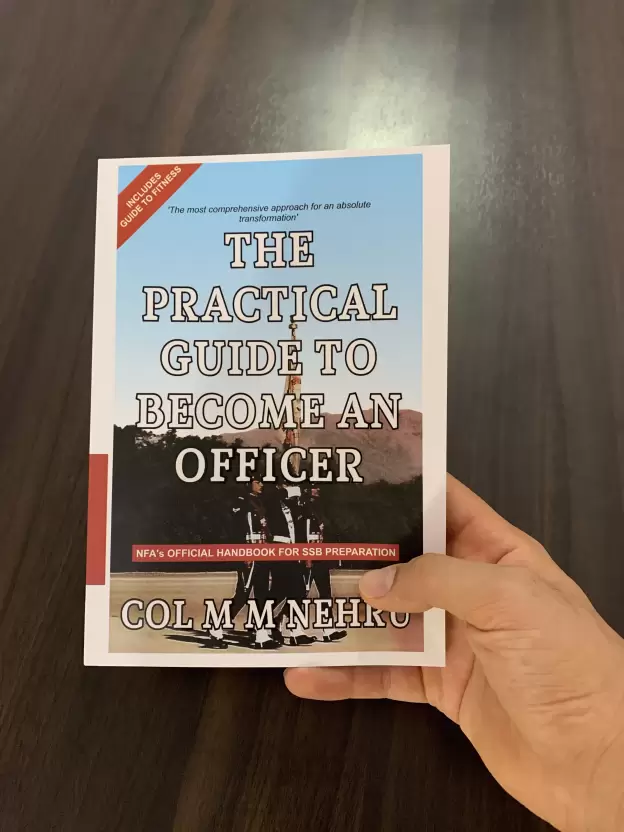Setting challenging yet achievable goals and then accomplishing them is the basic philosophy for personal growth and development. Often my students find this a difficult task, both in planning and execution. In this essay I have discussed a hypothetical plan of Judge Advocate General (JAG) Branch Defence aspirant to explain a simple plan for improvement. It must be remembered that execution of the plan will need the aspirant’s motivation, commitment and discipline to succeed. For the benefit of a large number of students having weak English a plan for it has also been explained.
Sample Studied Man A/Woman B
70 Day Plan
The aspirant enrolled for my guidance program approximately 80 days before his/her SSB. After the initial interview it was found that the individual had the following major weak areas:
- Knowledge of law.
- GK.
- Physical fitness and over-weight by approximately 10 kg.
The individual understood two things clearly:
- What aspects need improvement?
- How to effect the improvements?
The aspirant also realized that the time available with him/her was approximately 70 days (keeping a cushion of one week). The task in hand was apparently challenging but achievable.
Making of Plan
The aspirant realized that he/she has to establish firm goals and make a plan to accomplish them and thereafter work with focus to accomplish the goals with unwavering enthusiasm without getting deviated owing to self-doubts or comments of others.
Setting Goals
Law: The aspirant, after deliberation, listed out the following aspects that he/she should know about Law. He/she decided to be clear about all the topics given below and also remain updated with all issues related to law coming up in the news.
- Preamble: He/she realized that the Preamble to the Constitution is very important and learnt memorized it. He/she also realized that the 42nd Amendment was very important as it changed the description of India from a “sovereign democratic republic” to a “sovereign, socialist, secular, democratic republic”, and also changed the words “unity of the nation” to “unity and integrity of the nation”.
- Golaknath Case, 1967: This Supreme Court judgment established that the fundamental rights cannot be infringed by the Parliament.
- Kesavanand Bharti Case, 1973: This case gave birth to the “Basic structure” doctrine of the Constitution. The Supreme Court ruled that Constitution can be amended by the Parliament but not the basic structure. As to what constitutes the “basic structure” was not defined but it was left to be interpreted by the Supreme Court.
- ADM Jabalpur Case, 1976: It is widely regarded as the blackest day in the history of Indian judiciary. In this judgment the Supreme Court ruled that the fundamental rights stood suspended under emergency. This judgment was overruled in 2017 by a 4 judges’ bench.
- SR Bommai Case, 1993: This case acknowledged that secularism is a basic structure of the Constitution.
- Second Judges Transfer Case, 1993: This case established the primacy of CJI in appointment and transfer of judges to the high/Supreme Court.
- Vishakha Case, 1997: Post this case, Vishakha guidelines against sexual harassment of females in work places were established.
- AFSPA: Since AFSPA concerns the employment of the security forces in counter terrorist/insurgent operations, the knowledge is important.
- Recent Legal Issues of Significance
- NJAC Act was held as Unconstitutional by the Supreme Court.
- Women Permanent Commission: Women were granted permanent commission by a Supreme Court judgment in the Armed Forces.
- Article 370: The abrogation of Article-370 has been challenged in the Supreme Court. A 5 judges’ bench has not given judgment as yet despite the passage of one year.
- Habeas Corpus Petitions. Ninety nine per cent of the habeas corpus petitions filed with the Jammu and Kashmir High Court since the scrapping of Article 370 in August last year have remained pending.
- CAA: The Constitutional validity of CAA has not been heard as yet.
- Sabarimala Case: A 7 judges’ bench is yet to hear the case.
- SC/ST Creamy Layer Case: A 7 judges’ bench is yet to hear the case for the exclusion of creamy layer of SC/ST for reservation benefits.
GK: The student made the following plan to improve general knowledge:
- For current affairs the plan was to read the editorials of The Hindu or The Indian Express for about 45 min every day.
- For static aspects of GK it was planned to acquire high quality knowledge of the first 50 topics given by No Frills Academy.
Fitness: The student decided to not bother much about weight but focus on attaining the following fitness goals.
Fitness Goals
- Running- 5 km in 26 min/ 29 min; after 60 days: 27 min/ 31; after 30 days: 29 min/ 33 min
- Push-ups: 40/ 20; after 60 days: 30/15; after 30 days: 15/5.
- Chin-ups: 10/3; after 60 days: 7/2; after 30 days: 5/1.
- Sit-ups: 40; after 60 days: 30; after 30 days: 20.
- Squats: 100; after 60 days: 80; after 30 days: 60.
Plan to Improve English (Additional aspect included; not applicable for the Case under Discussion)
Goals
- To be able to speak in PPDT/GD/Lecturette without fumbling or groping for words.
- To be able to write SD without any grammatical or spelling mistakes.
- Vocabulary: To know the meanings of words that figure in editorials over 2 months.
Plan
The student planned to devote one hour every day for English improvement and send 30 sentences every week for checking for the first 6 weeks and then 2 essays on GK issues for No Frills Academy blog competition in the seventh and eighth week.
Routine for a Week
- 05:30 to 06:30 AM- cardio & stretching (running 3 days & cycling 3 days).
- 07:00 to 08:00 AM- paper & breakfast.
- 08:30 AM to 17:30 PM- work.
- 18:00 to 18:30- break + snacks.
- 18:30 to 19:30- strength exercises.
- 19:30 to 20:30 –bath + dinner.
- 20:30 to 21:30-law (4 days per week).
- 20:30 to 21:30- discussion with NFA group (two days per week).
- 21:30 to 22:30-static GK
- Sunday was kept absolutely free apart from reading the newspaper, playing some game and catching up with household chores or covering up on any aspect that was left during the working days.
Execution
The student found the going difficult in the first week and a little lesser in the second week. From the third week onward following the routine became quite easy and even enjoyable as the student started getting satisfaction in personal improvement.
The student found that by the 6th week all things were going on track and was pleasantly surprised to note that the goals set for Law and static GK had been accomplished. The student decided to cover more topics of static GK and also read more about the Army and the 1962 War to learn more about the situation on the LAC and history of India-China tension.
The student found that all the goals set had been accomplished as planned in 70 days. He/she used the balance time to revise and improve knowledge and fitness further, practice for OIR test and get more conversant with the SSB tests.
Performance
With high confidence built through the enhanced competence built over 75-80 days the student attended the SSB and got recommended.
Conclusion
This hypothetical plan is achievable and has been used successfully by several of our students.
BY – COL. MM NEHRU



